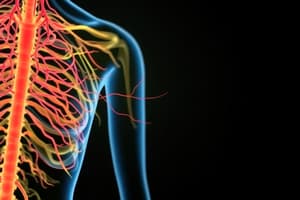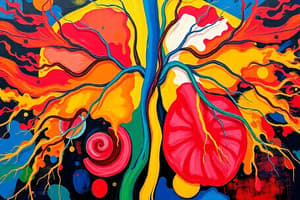Podcast
Questions and Answers
Which of the following is NOT a function regulated by the autonomic nervous system?
Which of the following is NOT a function regulated by the autonomic nervous system?
- Urinary bladder emptying
- GI motility
- Body temperature
- Visual acuity (correct)
What are the two major subdivisions through which efferent autonomic signals are transmitted?
What are the two major subdivisions through which efferent autonomic signals are transmitted?
- Cranial and spinal nerves
- Central and peripheral nervous systems
- Sensory and motor pathways
- Sympathetic and parasympathetic systems (correct)
Which of the following bodily functions is primarily influenced by the sympathetic nervous system?
Which of the following bodily functions is primarily influenced by the sympathetic nervous system?
- Decreased heart rate
- Bladder contraction
- Sweating (correct)
- GI secretion
Which physiological parameters are affected by the autonomic nervous system?
Which physiological parameters are affected by the autonomic nervous system?
What role does GI motility play in the autonomic nervous system?
What role does GI motility play in the autonomic nervous system?
From which areas do parasympathetic nerve fibers primarily originate?
From which areas do parasympathetic nerve fibers primarily originate?
Which part of the brain is NOT involved in the origin of parasympathetic nerve fibers?
Which part of the brain is NOT involved in the origin of parasympathetic nerve fibers?
The term 'craniosacral' in the context of parasympathetic nerve fibers refers to their origin in which regions?
The term 'craniosacral' in the context of parasympathetic nerve fibers refers to their origin in which regions?
Which of the following statements about parasympathetic nerve fibers is accurate?
Which of the following statements about parasympathetic nerve fibers is accurate?
How do the locations of origin for parasympathetic fibers differ from those of sympathetic fibers?
How do the locations of origin for parasympathetic fibers differ from those of sympathetic fibers?
What type of fibers secrete norepinephrine?
What type of fibers secrete norepinephrine?
Which statement correctly characterizes postganglionic parasympathetic fibers?
Which statement correctly characterizes postganglionic parasympathetic fibers?
Which of the following fibers does NOT secrete norepinephrine?
Which of the following fibers does NOT secrete norepinephrine?
What neurotransmitter is secreted by postganglionic parasympathetic fibers?
What neurotransmitter is secreted by postganglionic parasympathetic fibers?
Which type of fibers are classified as adrenergic?
Which type of fibers are classified as adrenergic?
Which type of receptors bind to acetylcholine and are located on postganglionic cell membranes?
Which type of receptors bind to acetylcholine and are located on postganglionic cell membranes?
What blocks the activity of nicotinic receptors?
What blocks the activity of nicotinic receptors?
Which of the following receptor types initiates the opening of non-specific cation channels upon activation by acetylcholine?
Which of the following receptor types initiates the opening of non-specific cation channels upon activation by acetylcholine?
What type of neurotransmitter do adrenergic receptors primarily bind to?
What type of neurotransmitter do adrenergic receptors primarily bind to?
Which of the following compounds activates muscarinic receptors?
Which of the following compounds activates muscarinic receptors?
Which type of receptors do sympathetic postganglionic nerve endings primarily act on?
Which type of receptors do sympathetic postganglionic nerve endings primarily act on?
What is the primary action of sympathetic postganglionic nerve endings?
What is the primary action of sympathetic postganglionic nerve endings?
Which of the following statements about sympathetic postganglionic actions is correct?
Which of the following statements about sympathetic postganglionic actions is correct?
What type of physiological response is likely mediated by α receptors activated by sympathetic postganglionic fibers?
What type of physiological response is likely mediated by α receptors activated by sympathetic postganglionic fibers?
Which of the following is NOT a characteristic of sympathetic postganglionic nerve action?
Which of the following is NOT a characteristic of sympathetic postganglionic nerve action?
What effect do adrenergic receptors have on the heart?
What effect do adrenergic receptors have on the heart?
Which statement correctly describes the effect of adrenergic receptors on blood vessels?
Which statement correctly describes the effect of adrenergic receptors on blood vessels?
Which of the following effects is associated with the stimulation of adrenergic receptors in the human body?
Which of the following effects is associated with the stimulation of adrenergic receptors in the human body?
What is the primary role of adrenergic receptors in the vascular system?
What is the primary role of adrenergic receptors in the vascular system?
How do adrenergic receptors affect overall cardiovascular function?
How do adrenergic receptors affect overall cardiovascular function?
What is the primary action of an agonist in the autonomic nervous system?
What is the primary action of an agonist in the autonomic nervous system?
Which of the following effects is associated with a more potent pressor action?
Which of the following effects is associated with a more potent pressor action?
What is the expected effect of an agonist on gastrointestinal (GI) motility?
What is the expected effect of an agonist on gastrointestinal (GI) motility?
What differentiates the relaxing effects on the gastrointestinal tract from the more pressor actions?
What differentiates the relaxing effects on the gastrointestinal tract from the more pressor actions?
Which of the following statements accurately describes an agonist's function?
Which of the following statements accurately describes an agonist's function?
Which of the following statements about nicotinic receptors is accurate?
Which of the following statements about nicotinic receptors is accurate?
What kind of agents can block muscarinic receptors?
What kind of agents can block muscarinic receptors?
Which type of receptor initiates the opening of non-specific cation channels upon activation?
Which type of receptor initiates the opening of non-specific cation channels upon activation?
What neurotransmitter do adrenergic receptors primarily bind to?
What neurotransmitter do adrenergic receptors primarily bind to?
Which receptor type is located on postganglionic cell membranes?
Which receptor type is located on postganglionic cell membranes?
What neurotransmitter is secreted by both preganglionic sympathetic and parasympathetic fibers?
What neurotransmitter is secreted by both preganglionic sympathetic and parasympathetic fibers?
Which of the following correctly describes the classification of preganglionic fibers in the autonomic nervous system?
Which of the following correctly describes the classification of preganglionic fibers in the autonomic nervous system?
Which characteristic is true regarding the neurotransmitters of the autonomic nervous system?
Which characteristic is true regarding the neurotransmitters of the autonomic nervous system?
What distinguishes cholinergic fibers in the autonomic nervous system?
What distinguishes cholinergic fibers in the autonomic nervous system?
Which statement accurately reflects the function of preganglionic autonomic fibers?
Which statement accurately reflects the function of preganglionic autonomic fibers?
What neurotransmitter is primarily secreted by postganglionic sympathetic fibers?
What neurotransmitter is primarily secreted by postganglionic sympathetic fibers?
Which type of postganglionic fibers are responsible for secreting acetylcholine?
Which type of postganglionic fibers are responsible for secreting acetylcholine?
Which statement accurately reflects the function of postganglionic sympathetic fibers?
Which statement accurately reflects the function of postganglionic sympathetic fibers?
Which of the following is a characteristic of cholinergic fibers?
Which of the following is a characteristic of cholinergic fibers?
What distinguishes the fibers that innervate sweat glands from other postganglionic sympathetic fibers?
What distinguishes the fibers that innervate sweat glands from other postganglionic sympathetic fibers?
What neurotransmitter is primarily secreted by postganglionic sympathetic fibers?
What neurotransmitter is primarily secreted by postganglionic sympathetic fibers?
Which type of postganglionic fibers are known to secrete acetylcholine?
Which type of postganglionic fibers are known to secrete acetylcholine?
What is the primary difference between postganglionic sympathetic fibers and those innervating sweat glands?
What is the primary difference between postganglionic sympathetic fibers and those innervating sweat glands?
Which classification of fibers secretes norepinephrine?
Which classification of fibers secretes norepinephrine?
Which statement accurately describes postganglionic parasympathetic fibers?
Which statement accurately describes postganglionic parasympathetic fibers?
Flashcards are hidden until you start studying
Study Notes
Autonomic Nervous System
- The efferent autonomic signals are transmitted to different organs through two major subdivisions: the sympathetic and parasympathetic nervous systems.
- Signals travel from the brain stem (midbrain, pons, and medulla) or the sacral spinal cord for the parasympathetic system.
- Preganglionic fibers originate from nuclei of cranial nerves (CN) III, VII, IX, and X, or from sacral spinal segments S2-S4.
- The parasympathetic system acts as one unit, with generalized action producing a catabolic effect that delays visceral content evacuation.
Parasympathetic System
- Parasympathetic system originates from the brain stem (midbrain, pons, and medulla) or the sacral spinal cord (craniosacral).
- Postganglionic fibers always secrete acetylcholine (Ach).
- The actions of acetylcholine stimulate nicotinic or muscarinic receptors in the postganglionic fibers.
- The parasympathetic system controls:
- Arterial pressure
- Heart rate
- GI motility
- GI secretion
- Urinary bladder emptying
- Sweating
- Body temperature
Autonomic Nervous System Neurotransmitters
- Postganglionic sympathetic fibers release norepinephrine (except for sweat glands which release acetylcholine).
- Postganglionic parasympathetic fibers release acetylcholine.
Cholinergic Receptors
- Nicotinic receptors are found on postganglionic cell bodies of all autonomic ganglia.
- They are activated by acetylcholine (endogenous) and nicotine (exogenous).
- They are blocked by curare and hexamethonium.
- Muscarinic receptors are found on effector cell membranes.
- They are activated by acetylcholine (endogenous) and muscarine (exogenous).
- They are blocked by atropine.
Adrenergic Receptors
- Alpha (α) receptors and beta (β) receptors bind to norepinephrine and epinephrine.
### Properties of Cholinergic Receptors
- Nicotinic receptors: binding of acetylcholine to these receptors initiates opening of non-specific cation channels.
- Muscarinic receptors: binding of acetylcholine to these receptors activates G-protein coupled signaling pathways which lead to a variety of effects.
Autonomic Agonists and Antagonists
- Agonists: bind to neurotransmitter receptors and cause the same response as the neurotransmitter would.
- Antagonists: bind to neurotransmitter receptors and block the action of the neurotransmitter.
Autonomic Neurotransmitters
- Preganglionic sympathetic and parasympathetic fibers are cholinergic as they secrete acetylcholine
- Post ganglionic sympathetic fibers are adrenergic as they secrete norepinephrine, except those fibers to sweat glands, which are cholinergic
- Post ganglionic parasympathetic fibers are cholinergic as they secrete acetylcholine
Autonomic Neurotransmitter Receptors
- Tissues innervated by the autonomic nervous system have different receptor types for postganglionic chemical messengers
- Cholinergic receptors bind to acetylcholine
- Nicotinic receptors are found on postganglionic cell bodies of all autonomic ganglia
- Muscarinic receptors are found on effector cell membranes
- Adrenergic receptors bind to norepinephrine and epinephrine
- Alpha (α) receptors
- Beta (β) receptors
Nicotinic Receptors
- Activated by acetylcholine endogenously and nicotine exogenously
- Blocked by curare and hexamethonium
Muscarinic Receptors
- Activated by acetylcholine endogenously and muscarine exogenously
- Blocked by atropine
Properties of Cholinergic Receptors
- Nicotinic receptors: binding of Ach to these receptors initiates opening of non-specific cation channels
- Adrenergic receptors: binding of norepinephrine and epinephrine causes a variety of effects:
- Effect on the Heart: Strong effect on the heart (by β1 receptors) are stronger than on the blood vessels (by β2 receptors)
- Effect on the Blood Vessels:
- Alpha receptors cause vasoconstriction
- Beta receptors cause vasodilation
- β2 agonists (e.g. Salbutamol) are used as bronchodilators
- Antagonists: bind with the receptor preventing the neurotransmitter from binding and causing a response
- e.g. Atropine is a muscarinic antagonist
- e.g. Propranolol is a β blocker
- e.g. Phenylephrine is an alpha agonist
Autonomic Nervous System
- Sympathetic postganglionic fibers are adrenergic and secrete norepinephrine (except for fibers to sweat glands).
- Parasympathetic postganglionic fibers are cholinergic and secrete acetylcholine.
- Cholinergic receptors bind to acetylcholine. There are two types:
- Nicotinic receptors found on postganglionic cell bodies of all autonomic ganglia.
- Muscarinic receptors found on effector cell membranes.
- Adrenergic receptors bind to norepinephrine and epinephrine. There are two types:
- Alpha (α) receptors.
- Beta (β) receptors.
Nicotinic Receptors
- Activated by acetylcholine endogenously and nicotine exogenously.
- Blocked by curare and hexamethonium.
Muscarinic Receptors
- Activated by acetylcholine endogenously and muscarine exogenously.
- Blocked by atropine.
Properties of Cholinergic Receptors
- Nicotinic receptors: binding of Ach to these receptors initiates opening of non-specific cation channels.
- Muscarinic receptors: binding of Ach initiates G protein-linked receptors pathways, depending on the effector organ.
Properties of Adrenergic Receptors
- α1 & α2 receptors have greater sensitivity to norepinephrine.
- β2 receptors bind exclusively with epinephrine.
- β1 receptors have equal affinity for epinephrine and norepinephrine.
- All adrenergic receptors are linked to G protein.
- Activation of β1 & β2 activates cAMP.
- Activation of α1 activates IP3 /Ca2+.
- Activation of α2 inhibits cAMP in target cells.
Effect of ANS on Various Organs
| Organ | Sympathetic | Parasympathetic |
|---|---|---|
| Heart | + (increase heart rate and contractility) | - (decrease heart rate) |
| Blood Vessels | Constrict (most organs) | Dilate (penis and clitoris) |
| Blood Vessels (Skeletal Muscles) | Dilate | |
| Bronchioles | Dilate | Constrict |
| Pupil | Dilate | Constrict |
| Digestion | Inhibit | Enhance |
Norepinephrine and Epinephrine
- Norepinephrine is secreted by:
- Adrenal medulla (80% of its secretion).
- Sympathetic postganglionic nerve endings.
- Epinephrine is secreted by:
- Adrenal medulla (20% of its secretion).
- Norepinephrine acts on both α and β receptors.
- Epinephrine mainly acts on α receptors.
- Salbutamol is a β2 agonist (bronchodilator).
- Antagonists bind to the receptor and prevent the neurotransmitter from binding and causing a response.
Studying That Suits You
Use AI to generate personalized quizzes and flashcards to suit your learning preferences.





